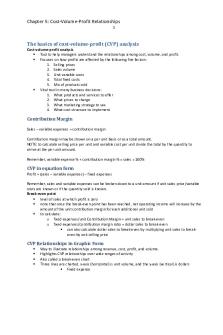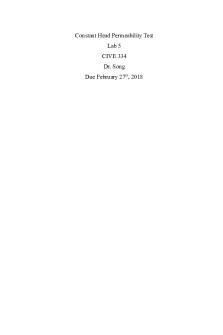Porosity – Permeability Relationships PDF

| Title | Porosity – Permeability Relationships |
|---|---|
| Author | Lee Sam |
| Pages | 22 |
| File Size | 359.4 KB |
| File Type | |
| Total Downloads | 783 |
| Total Views | 943 |
Summary
Porosity – Permeability Relationships Permeability and porosity trends for various rock types [CoreLab,1983] Porosity – Permeability Relationships Influence of grain size on the relationship between porosity and permeability [Tiab & Donaldson, 1996] Porosity – Permeability Relationships • Darcy’...
Description
Porosity – Permeability Relationships
Permeability and porosity trends for various rock types [CoreLab,1983]
Porosity – Permeability Relationships
Influence of grain size on the relationship between porosity and permeability [Tiab & Donaldson, 1996]
Porosity – Permeability Relationships • Darcy’s Law 18 permeability
– empirical observations of flow to obtain
• Slichter (1899) – theoretical analysis of fluid flow in packed uniform spheres • Kozeny (1927),Carmen (1939) – capillary tube model
Porosity – Permeability Relationships Capillary Tube Model ntr 2 Define porosity Where r is radius of the capillary tube, nt is number of tubes/ unit area
Define permeability
k
n t r
Porosity-permeability relationship
4
8
r2 k 8
Porosity – Permeability Relationships Example
For cubic packing shown, find and k. Number of tubes per unit area: 4 tubes/(4r)2 Porosity
Tortuosity
Permeability
2 1 * r 2 4 4r
La L
2 1
r 2 r 2 r 2 * k 8 4 8(1) 32
r
Porosity – Permeability Relationships Carmen – Kozeny Equation
Define specific surface area Spv – specific surface area per unit pore volume Spv = 2/r (for cylindrical pore shape)
k
Sbv- …u it bulk volu e Sgv- …u it grai volu e S bv * S pv
S S gv pv 1
r2 k 8
L a L
2
Spv = 2/r
2 k z S pv
Where Kz, Kozeny constant-shape factor to account for variability in shape and length
Porosity – Permeability Relationships Carmen – Kozeny Equation k
r 8
Spv = 2/r
2
k
2 k z S pv
Where Kz, Kozeny constant-shape factor to account for variability in shape and length
Carmen – Kozeny Equation k z ko *
Tortuosity,
La L
2
ko is a shape factor = 2 for circular = 1.78 for square
Porosity – Permeability Relationships
Example: spherical particles with diameter, dp k
2 k z S pv
?? k
3d 2p
721 2
Distribution of Rock Properties Porosity Distribution
Expected porosity histogram [Amyx,et at., 1960]
Distribution of Rock Properties Porosity Distribution 1.2
10 9
Frequency
7
0.8
6 5
0.6
4 0.4
3 2
0.2
1 0
0.0 4
6
8
10
12
14
16
18
20
22
24
26
28
Porosity , %
Actual porosity histogram [NBU42W-29, North Burbank Field]
Cum ulative Frequency
1.0
8
Distribution of Rock Properties
Permeability Distribution
Expected Skewed normal and log normal histograms for permeability [Craig,1971]
Distribution of Rock Properties
Permeability Distribution 25
frequency
20
15
10
5
0 0.01
0.10
1.00
10.00
100.00
1,000.00
Permeability, md
Actual permeability histogram [NBU42W-29, North Burbank Field]
Distribution of Rock Properties
Permeability Variation Dykstra-Parsons Coefficient k 50 k 84.1 V k 50
Characterization of reservoir heterogeneity by permeability variation [Willhite, 1986]
Distribution of Rock Properties Permeability Variation
Example of log normal permeability distribution [Willhite, 1986]
Distribution of Rock Properties Permeability Variation 10000.000 1000.000 Flow units
k,md
100.000 10.000
y = 578.37e-4.647x R² = 0.9917
1.000 0.100 0.010 0.001 0.0
0.2
0.4
0.6
0.8
probability of samples with permeability >
Actual Dykstra-Parsons probability plot [NBU42W-29, North Burbank Field]
1.0
Distribution of Rock Properties Permeability Variation Lorenz Coefficient
Lk
Area ABCA Area ADCA
Flow capacity vs storage capacity distribution [Craig, 1971]
Distribution of Rock Properties Permeability Variation
Flow Capacity Distribution 1
0.643
0.9 Fraction of total Flow Capacity
Lorenz Coefficient Area ABCA Lk Area ADCA
0.8 0.7 0.6
0.5 0.4 0.3 y = -3.8012x4 + 10.572x3 - 11.01x2 + 5.2476x - 0.0146 R² = 0.9991
0.2 0.1 0 0
0.2
0.4
0.6
0.8
Fraction of total Volume
Actual Lorenz plot [NBU42W-29, North Burbank Field]
1
Distribution of Rock Properties Drawback of statistical approaches • Sequential ordering of data depth
Schematic of statistical approach of arranging data in comparison to true reservoir data, which is not ordered. arranged
un-arranged
• reliance only on permeability variations for estimating flow in layers. Does not account for: – phase mobility, pressure gradient, Swirr and the k/ ratio
Distribution of Rock Properties Hydraulic Flow Unit • unique units with similar petrophysical properties that affect flow. – Hydraulic quality of a rock is controlled by pore geometry – It is the distinction of rock units with similar pore attributes, which leads to the separation of units into similar hydraulic units. – not equivalent to a geologic unit. The definition of geologic units or facies are not necessarily the same as the definition of a flow unit.
HFU1
HFU2
HFU3 HFU4
Schematic illustrating the concept of flow units.
Distribution of Rock Properties • Start with CK equation
1 1 k S o gv k
• Take the log
log( RQI ) log( r ) log( FZI )
where the Reservoir quality index (RQI) is given by, RQI {m} 0.0314
k{md}
the Flow Zone Indicator (FZI) is, FZI
1 S gv k z
and the pore-to-grain volume ratio is expressed as r
1
Plot of RQI vs r for East Texas Well [Amaefule, et al.,1993]
Distribution of Rock Properties 10.000
10.000
FZI 4.0 2.6 1.8
1.000
1.000
RQI
RQI
0.5
0.100
0.100
0.010 0.010
0.100
1.000
0.010 0.010
Porosity Ratio
HFU [NBU42W-29, North Burbank Field]
0.100 Porosity Ratio
1.000
Distribution of Rock Properties 10
10000.000
9 1000.000
8
Flow units
7
10.000
Frequency
k,md
100.000 y = 578.37e-4.647x R² = 0.9917
1.000 0.100 0.010
6
FZI4
5
FZI3
4 3
FZI2
2
FZI1
1 0
0.001 0.0
4 6 8 10 12 14 16 18 20 22 24 26 28
0.2 0.4 0.6 0.8 1.0 probability of samples with permeability >
Porosity, %
10.000
1E+04
FZI
1E+03
4.0 2.6
1E+02 1.8 0.5
RQI
permeability
1.000 1E+01 1E+00 1E-01 1E-02 1E-03 0.00
0.100
k = 6E+066.9644 R2 = 0.9014 0.10
0.20 porosity
0.30
0.40
0.010 0.010
0.100 Porosity Ratio
1.000...
Similar Free PDFs

Porosity and permeability lab
- 4 Pages

Porosity Measurement
- 6 Pages

High Porosity Dos and Donts
- 1 Pages

Basic-Porosity-Concept
- 5 Pages

positive relationships
- 4 Pages

ECG428 LAB 5 PERMEABILITY TEST
- 9 Pages

2-Angle Pair Relationships
- 4 Pages

Ch 13 - Peer Relationships
- 5 Pages

CVP Relationships Notes
- 4 Pages

Ch09 Spousal Relationships
- 14 Pages
Popular Institutions
- Tinajero National High School - Annex
- Politeknik Caltex Riau
- Yokohama City University
- SGT University
- University of Al-Qadisiyah
- Divine Word College of Vigan
- Techniek College Rotterdam
- Universidade de Santiago
- Universiti Teknologi MARA Cawangan Johor Kampus Pasir Gudang
- Poltekkes Kemenkes Yogyakarta
- Baguio City National High School
- Colegio san marcos
- preparatoria uno
- Centro de Bachillerato Tecnológico Industrial y de Servicios No. 107
- Dalian Maritime University
- Quang Trung Secondary School
- Colegio Tecnológico en Informática
- Corporación Regional de Educación Superior
- Grupo CEDVA
- Dar Al Uloom University
- Centro de Estudios Preuniversitarios de la Universidad Nacional de Ingeniería
- 上智大学
- Aakash International School, Nuna Majara
- San Felipe Neri Catholic School
- Kang Chiao International School - New Taipei City
- Misamis Occidental National High School
- Institución Educativa Escuela Normal Juan Ladrilleros
- Kolehiyo ng Pantukan
- Batanes State College
- Instituto Continental
- Sekolah Menengah Kejuruan Kesehatan Kaltara (Tarakan)
- Colegio de La Inmaculada Concepcion - Cebu





